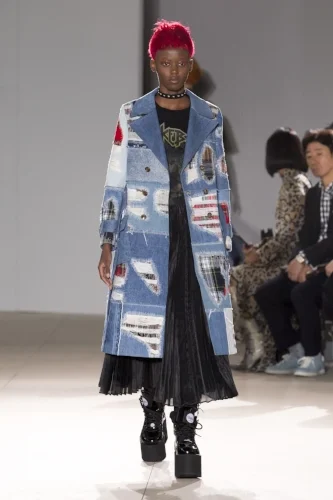Junya Watanabe Pulled on Familiar Fabrics in an SS2019 Reformation
By Taraneh Azar, Runway Correspondent
Photography courtesy of Yannis Vlamos / Indigital.tv for Vogue Runway
Fans of Junya Watanabe’s signature haute-deconstructed approach know one of his collections when they see it. Watanabe, an ever-present name in the fashion world for decades, is often cited for his incorporation of denim patchwork into his 2011 and 2013 collections. While the designer stepped away from denim after 2013, his Spring Summer 2019 Paris Fashion Week presentation revisited the fabric with an avant-garde yet instantly familiar application for the eager diehards of all things Comme Des Garçons.
Watanabe said in an e-mail before the show that he sought to “express the romantic feeling of rock”, which he achieved in an artfully sophisticated, experimental and innovative way. This desire brought models with multi-colored hair and bondage chokers in Watanabe’s recurring pseudo-goth styling to the runway in reconstructed patchwork denim smocks and tutus styled with distressed band t-shirts. What looked like full denim hoop-skirt gowns turned out to be hiding plain jeans in the back. Familiar halter denim dresses were styled with white shirts and tight tattoo tops.
Although the denim revival launched the show, the presentation evolved to showcase a spectrum of quintessential American fabrics, incorporating chambray gowns and khaki tutus juxtaposed with floral patterns. Watanabe also worked plaid in with denim of all washes as they were affixed onto stiff trench-blazers styled with dirty t-shirts and ground-sweeping silk skirts. Watanabe utilized all of his characteristic distressing, destroying, and repurposing techniques to create half-denim half-lace fabric jumpers styled with chunky Buffalo-collaboration sneakers and platform boots alike. Spiked chains and bright orange, neon green, and hot pink bobs and pixie cuts were styled effortlessly with ripped jeans, patchwork denim pants and massive tutu, lace-lined dresses.
The show’s closing look, however, was a true summary of the collection: a silk-satin bustier-top flowed into a lop-sided tutu gown fastened together with leather bondage belts, all styled with a BDSM choker, chunky high-tops and patchwork denim-corduroy jeans. The look conveyed the balance between submission and rebellion, traditional femininity and subversive rejection, stiff cuts and flowing fabrics, embodying all at once what the rest of the collection explored piecemeal.
Watanabe’s Ready to Wear collection left viewers with a sense that 1980s punk England had met 1990s New York Club Kids in a way that felt reminiscent of Vivienne Westwood’s work. While the collection is undoubtedly the work of Watanabe, the plaid patterns, baggy yet stiff and restrictive cuts, suspender jumper-skirts, edgy British punk colored hair, and youthful and subversive styling alludes to what Westwood is best known for. The balance between the deconstructed blue jeans coupled with Watanabe’s intricate revamp of the classic material made this collection a symbol of the appreciation for reworking known and loved phenomena for a future of regeneration. Who’s surprised, though? Reinventing traditional garments, cuts, and fabrics is what Watanabe is known for.











